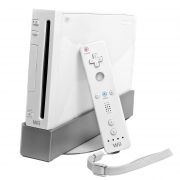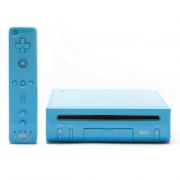Wii:Buying Guide
The Wii was a very successful console for Nintendo, and following their usual pattern, it had a few redesigns and models over the years. All Wii models follow the model name convention of RVL-X01. RVL stand for Revolution, which was the internal name for the Wii during development, while the X is a number in order of release, either 0, 1, or 2.
The original Wii launched in 2006, and wouldn’t have a true external facelift until 2011. However, there were some under the hood changes made between 2006 and 2011.
The first few revisions of the Wii motherboard (RVL-CPU-01, RVL-CPU-10, RVL-CPU-20, and RVL-CPU-30) were 6 layer boards. They were plagued by overheating issues in WiiConnect24 standby mode, and they also consumed more power compared to the later revisions. Only a very small amount of these boards have the patched version of boot1 that doesn’t allow the installation of BootMii as boot2. These boards were all shipped with Hollywood GPU chips and are capable of running all versions of Wii software.
Later on, Nintendo redesigned the board and the Hollywood GPU chip. The boards were now 4 layer boards, meaning they did not overheat and consumed less power, and these boards all used the revised Hollywood-1 (aka Bollywood) GPU chip. These new chips are not capable of running Wii software older than System Menu 3.2. Lastly, all these boards had boot1 patched to be incompatible with BootMii as boot2. The RVL-CPU-40 was the first board to use this design, and all future boards continued to use it.
All non-white original Wiis have the revised 4 layer motherboard, and most of the white ones have the older 6 layer board.
The Wii board was mostly left untouched after the 4 layer redesign…until 2011.
In 2011, Nintendo debuted the Wii Family Edition, model number RVL-101. This board was not too different from the previous 4 layer boards, with one main exception: the GameCube ports were removed from the board. The original Wii Family Edition board had the number RVK-CPU-01. There was a later revision, the RVK-CPU-02, released later on.
In late 2012, Nintendo released the last revision of the Wii, the Wii Mini, model number RVL-201. It was a heavily stripped down version of the previous 4 layer boards. It lacked GameCube compatibility like its immediate predecessor, along with a lack of an SD slot, Wi-Fi support, component video support, only one USB port instead of two and it ditched the slot loading drive of the two previous revisions in favor of a top loading drive. There is only one confirmed version of the Wii Mini board, and that is the RVO-CPU-01.
Each model has its pros and cons. However, all of the versions can be softmodded with varying degrees of difficulty.
Launch Model - RVL-001
This model was the first to launch. It was designed to stand up on the included stand, with all the buttons being labelled to be read when the console was vertical. On the top side, there were flaps that covered four GameCube controller ports, as well as two GameCube memory card slots. This model was capable of playing GameCube games natively using all compatible accessories that could fit into the included slots.
Each console has two USB ports in the back, as well as a 12V AC in, sensor bar power port, and an AV out port. On the front side, there are three buttons visible: the power button, reset button, and disc eject button. There is also a flap on the front side of the console. Opening this reveals a controller sync button and an SD card slot, with support for up to 32 GB officially (although larger sizes have been unofficially confirmed to work as well) on later versions of the system software. This side also has the disc drive, which uses a slot-loading mechanism.
Three colors were made of this model: white, black, and red. The white model was the only one available at launch, with the black and red models releasing later.
“RVL-CPU-01/20” (2006-200?)
The original launch model revisions of the RVL-001. Taking up the most space (6 layer), consuming the most power, and outputting slightly worse video than later revisions in two different ways, these are not really worth getting. Their only positive is that they’ll often have DVD support, which isn’t very relevant nowadays. To identify these (as for other board revisions), unscrew the Wii’s clock battery on the bottom, and look inside for “01” or “20”.
“RVL-CPU-30” (200?-2009)
While retaining the reduced video output of the 01 & 20s, this revision has a markedly lower power output and consumption. However, they still are 6 layers, and they did remove DVD support. Otherwise, these are an OK midpoint between the worst (01/20) and best (40/60) RVL-001 revisions. To identify these, look for the “30” inside the Wii after unscrewing the clock battery.
“RVL-CPU-40/60” (2010-2011)
These boards were reduced to 4 layers, and have a low power consumption. Furthermore, two aspects of video quality improved. First, a small SDK/software-based 480p rendering bug was corrected, resulting in slightly superior pixel alignment in ALL software. Second, the video chip has been improved in an unknown way, which causes the component output itself to become noticeably clearer. These don’t have DVD support. 60s consume slightly less power than the 40s. To identify these, look for the “40/60” inside the Wii after unscrewing the clock battery. Alongside this, ALL RVL-001 consoles in red, black, or blue are guaranteed to be of this revision, as they were made after Q4 2009/Q1 2010(?). White RVL-001 systems can also be a 40 or 60, but one must unscrew the clock battery to find this out, unlike the colored RVL-001 systems.
Family Edition - RVL-101
The second model to launch, around 2011. This model was designed to be placed horizontally, with the button labels reflecting this change. It has almost all of the same input and output ports, including USB and SD. However, the difference is that this model entirely removed all GameCube controller and memory card ports, as well as the ability to play GameCube discs. Doing so caused either full or partial incompatibility with certain Wii games that utilized the GameCube controller ports. However, the software on the RVL-101 is still capable of playing GameCube games, allowing homebrew GameCube loaders such as Nintendont to still work on these Wiis. Additionally, the solder pads for the GameCube controller and memory card ports are still present on the board, meaning the ports can be soldered back on and used normally.
List pulled from Nintendo's Wii model differences list
| Game Name | Full or partial |
|---|---|
| Active Life: Explorer | Full |
| Active Life: Extreme Challenge | Full |
| Active Life: Magical Carnival | Full |
| Active Life: Outdoor Challenge | Full |
| Dance Dance Revolution | Partial |
| DanceDanceRevolution II | Partial |
| Dance Dance Revolution: Disney Grooves | Partial |
| DanceDanceRevolution Hottest Party | Partial |
| DanceDanceRevolution Hottest Party 2 | Partial |
| DanceDanceRevolution Hottest Party 3 | Partial |
| Ultimate Party Challenge | Full |
| Walk It Out | Partial |
This model was produced in three colors: white, black, and blue. Each had a corresponding Wii Remote and Nunchuck of the same color.
Wii Mini - RVL-201
The last revision of the Wii, initially released exclusively in Canada in 2012, and later releasing in the United States and Europe. This console featured a top loader disc drive as opposed to the slot loader of the previous 2 revisions, as well as power and eject buttons next to the drive, more similar to those of the GameCube than to its previous versions. It also only had one USB slot, and removed the SD card slot featured in previous models. The reset button was also removed.
The ports on the back of the console remained largely the same besides the removal of one USB port, with one exception: while previous models were capable of outputting composite video up to 480i or component video up to 480p, the latter was removed from the Wii Mini, meaning only composite cables can be used, and the Wii Mini will only output a maximum resolution of 480i.
This model officially cannot connect to the internet, lacking both Wi-Fi and Ethernet-over-USB support. This means that any game with an online component would be partially incompatible with this console, typically removing things such as online multiplayer. Because of the lack of online access, the console cannot be updated. Even if a disc update is attempted, the software version numbers of the Wii Mini have been made higher than all existing official Wii software, meaning no updates will be found.
This version of the console is also incompatible with all the games listed in the RVL-101 model portion, due to a lack of GameCube ports.
Although none of the homebrew exploits that existed for previous revisions are compatible with the Wii Mini due to the removal of the features they relied on, the Bluebomb exploit is compatible with the Wii Mini, and it is the only way to softmod a stock Wii Mini.
Through homebrew (specifically the Ethernet Enabler app), it is possible to use a USB LAN adapter to connect the Wii Mini to the internet.
While the Wii Mini is heavily stripped down compared to the RVL-001 and RVL-101 models, the motherboard still contains the test points for the SD card slot, GameCube ports, and the reset button. The board is also capable of all the other features that were stripped from this revision. With some soldering work (both easy and difficult) and some slight software changes, it is possible to restore all of the missing features, including component video, Wi-Fi, the SD card slot, and more.
References
https://en.wikipedia.org/wiki/Wii#Revisions
https://io55.net/wiki/eop/video_game_consoles-home/7th_generation/nintendo_wii
https://www.reddit.com/r/WiiHacks/comments/h8geiy/what_wii_should_you_get_a_complete_guide_on_the/
https://shmups.system11.org/viewtopic.php?p=1235894#p1235894 (revision component tips)
https://gbatemp.net/threads/wii-480p-video-bug-discovered.536599/ (480p software bug tips)
http://forums.modretro.com/index.php?threads/wii-board-revisions-guide.14059/


